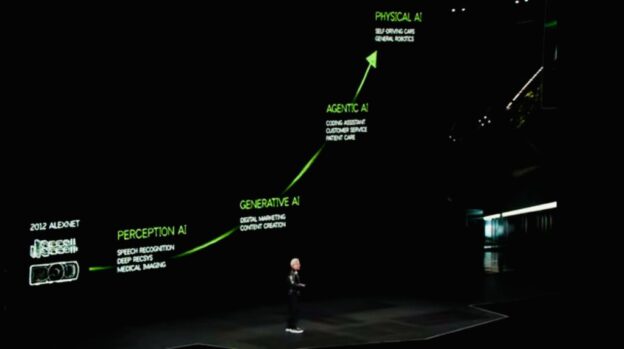At CES NVIDIA CEO Jensen Huang proposes a three-computer solution to the figurative three-body problem of physical AI—using a digital twin to connect and refine physical AI training and deployment
Whether it’s an autonomous vehicle (AV), highly-digitized, lights-out manufacturing environments or use case involving humanoid robotics, NVIDIA CEO Jensen Huang, speaking in a keynote during the Consumer Electronics Show (CES) earlier this week in Las Vegas, Nevada, sees it as a three-body problem with a three-computer solution.
First things first, the Three-Body Problem, from 2008, is the first book in a trilogy by Chinese author Liu Cixin. The titular “problem” is a physics classic—how do you calculate the trajectories of three co-orbiting celestial bodies at a point in time using Newtonian mathematics. In the novels, an alien race’s approach to solving the three-body problem sets off a multi-generational thriller that’s well worth the read. In Huang’s keynote, the three-body problem of training, deploying and continuously optimizing objects with autonomous mobility, is addressed by a three-computer solution.
“Every robotics company will ultimately have to build three computers,” Huang said. “The robotics system could be a factory, the robotics system could be a car, it could be a robot. You need three fundamental computers. One computer, of course, to train the AI…Another, of course, when you’re done, to deploy the AI…that’s inside the car, in the robot, or in an [autonomous mobile robot]…These computers are at the edge and they’re autonomous. To connect the two, you need a digital twin…The digital twin is where the AI that has been trained goes to practice, to be refined, to do its synthetic data generation, reinforcement learning, AI feedback and such and such. And so it’s the digital twin of the AI.”
So, he continued, “These three computers are going to be working interactively. NVIDIA’s strategy for the industrial world, and we’ve been talking about this for some time, is this three-computer system. Instead of a three-body problem, we have a three-computer solution.”
And those three computers are: the NVIDIA DGX platform for AI training, including hardware, software and services; the NVIDIA AGX platform, essentially a computer to support computationally-intensive edge AI inferencing; and then a digital twin to connect the training and inferencing which is NVIDIA Omniverse, a simulation platform made up of APIs, SDKs and services.
Here’s what’s new. At CES, Huang announced NVIDIA Cosmos, a world foundation model trained on 20 million hours of “dynamic physical things,” as the CEO put it. “Cosmos models ingest text, image or video prompts and generate virtual world states as videos. Cosmos generations prioritize the unique requirements of AV and robotics use cases, like real-world environments, lighting and object permanence.”
NVIDIA takes on physical AI for automotive, industrial and robotics





